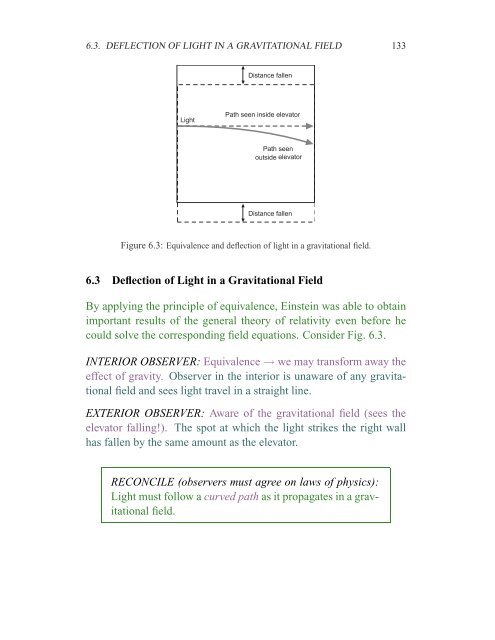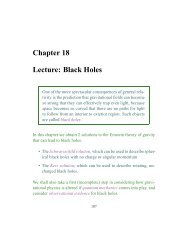Chapter 6 Lecture: Principle of Equivalence
Chapter 6 Lecture: Principle of Equivalence
Chapter 6 Lecture: Principle of Equivalence
You also want an ePaper? Increase the reach of your titles
YUMPU automatically turns print PDFs into web optimized ePapers that Google loves.
6.3. DEFLECTION OF LIGHT IN A GRAVITATIONAL FIELD 133<br />
Light<br />
Distance fallen<br />
Path seen inside elevator<br />
Path seen<br />
outside elevator<br />
Distance fallen<br />
Figure 6.3: <strong>Equivalence</strong> and deflection <strong>of</strong> light in a gravitational field.<br />
6.3 Deflection <strong>of</strong> Light in a Gravitational Field<br />
By applying the principle <strong>of</strong> equivalence, Einstein was able to obtain<br />
important results <strong>of</strong> the general theory <strong>of</strong> relativity even before he<br />
could solve the corresponding field equations. Consider Fig. 6.3.<br />
INTERIOR OBSERVER: <strong>Equivalence</strong> → we may transform away the<br />
effect <strong>of</strong> gravity. Observer in the interior is unaware <strong>of</strong> any gravitational<br />
field and sees light travel in a straight line.<br />
EXTERIOR OBSERVER: Aware <strong>of</strong> the gravitational field (sees the<br />
elevator falling!). The spot at which the light strikes the right wall<br />
has fallen by the same amount as the elevator.<br />
RECONCILE (observers must agree on laws <strong>of</strong> physics):<br />
Light must follow a curved path as it propagates in a gravitational<br />
field.



